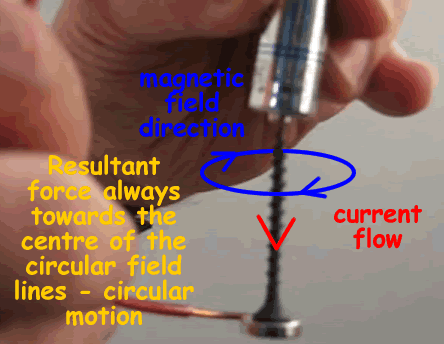|
When a
wire carrying an electric current is placed in a magnetic field, it may
experience a force. Why should this be?
It is 'simples' really...
 When a wire carries a current it has a magnetic field around it. (You did this when you studied electromagnetism). When a wire carries a current it has a magnetic field around it. (You did this when you studied electromagnetism).
 You therefore have two magnetic feilds: the field from the fixed magnet interacts with the field due to the current. You therefore have two magnetic feilds: the field from the fixed magnet interacts with the field due to the current.
 This can cause the wire to be attracted or repelled from the fixed magnet, depending on its orientation. This can cause the wire to be attracted or repelled from the fixed magnet, depending on its orientation.
 If the force the wire experiences is strong enough (meaning that the wire has a small enough mass so that gravity doesn't stop it moving) you will see the effect of the attraction/repulsion in movement of the wire as movement. If the force the wire experiences is strong enough (meaning that the wire has a small enough mass so that gravity doesn't stop it moving) you will see the effect of the attraction/repulsion in movement of the wire as movement.
 The force experienced by the wire is at a maximum when the current is flowing
at right angles to the field lines of the fixed magnet and is zero when it is parallel to
them. The force experienced by the wire is at a maximum when the current is flowing
at right angles to the field lines of the fixed magnet and is zero when it is parallel to
them.
The size of the force on the wire can be increased
by:
 increasing the strength of the magnetic
field it experiences; increasing the strength of the magnetic
field it experiences;
 increasing the size of the current flowing through it. increasing the size of the current flowing through it.
 increasing the number of turns of
wire experiencing the magnetic field. increasing the number of turns of
wire experiencing the magnetic field.
| The direction of the force is reversed if either the direction of the current or the direction of the magnetic field is reversed. It can be found using Fleming's Left Hand Motor Rule. (You can remember that it is the left had by remembering that in Britain we drive motor cars on the left hand side of the road - or by remembering that the motor rule predicts the direction of a resulting orce and LEhas an in it). |
|
See Also:
 Electric
Motor Electric
Motor
 Loudspeaker Loudspeaker
 Revision
of KS3 work on magnets
and electromagnets Revision
of KS3 work on magnets
and electromagnets
 Force
on a moving charge (A level) Force
on a moving charge (A level)
 Force on
a current carrying wire (GCSE) Force on
a current carrying wire (GCSE)
 An
experiment to illustrate the Force on a Wire in a Magnetic Field: An
experiment to illustrate the Force on a Wire in a Magnetic Field:
At GCSE level you should be able
to use diagrams and/or other appropriate information to explain
how electromagnetic effects are used in simple d.c.
motors and circuit breakers.
NB
Details of the split ring commutator,
for reversing the current to a d.c. motor each half turn, may not
be examined - look carefully at the syllabus to see what is required - boards change their minds so often!
Here is an interesting demonstration that you could try at home!


|











